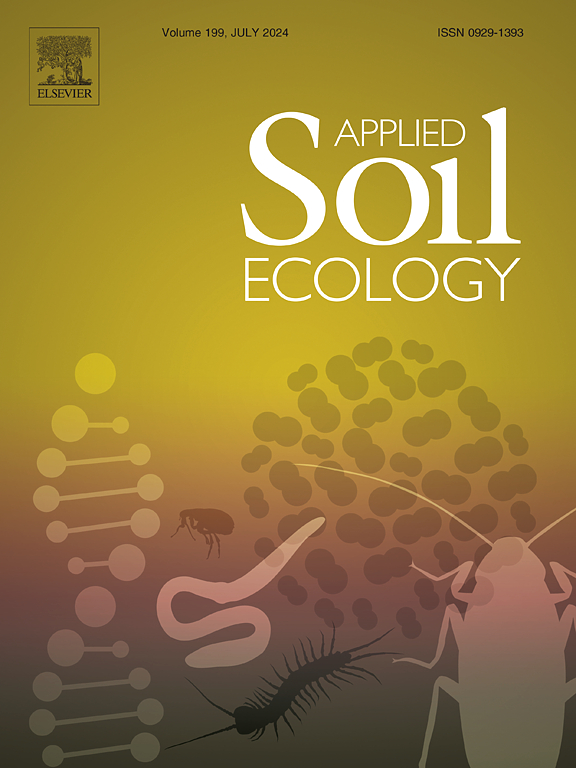Toxicity of polyethylene microplastics and atrazine to microorganisms in soil and gut of earthworms
IF 5
2区 农林科学
Q1 SOIL SCIENCE
引用次数: 0
Abstract
Nowadays, microplastics (MPs) extensively exist in soil environment, atrazine is an extensively utilized herbicide which residues accumulate in soil. The harmful effects of atrazine on earthworms are well investigated, however, the toxicity of co-exposure of MPs and atrazine to bacterial community in soil and gut of earthworms was unclear. Herein, the changes of bacterial communities in the soil and the gut of earthworms exposed to binary pollutants (MPs and atrazine) were investigated. The results showed that atrazine increased relative abundance of some soil indigenous atrazine-degrading bacteria (Pseudomonas, Flavobacterium) and gut-colonizing bacteria (Algoriphagus, Aeromonas) in the soil after 28 days, however, the relative abundance of Verminephrobacter and Muribaculaceae in earthworm gut decreased from 5.6 % to 1.0 % and from 7.3 % to 2.2 %, respectively. After introducing MPs, the relative abundance of Verminephrobacter and Aeromonas (intestinal dysbiosis markers) in earthworm gut enhanced from 5.6 % to 13.5 % and from 0.2 % to 3.1 %, respectively. Co-exposure to atrazine and MPs increased the relative abundance of Bacteroidota. Single or binary of atrazine and MPs have adverse effects on metabolism of gut microbiota. The results revealed the adverse effects of MPs and atrazine on microorganisms in soil and earthworm gut, deepening the knowledge of the influence of MPs and atrazine on soil ecology.

聚乙烯微塑料和阿特拉津对土壤和蚯蚓肠道微生物的毒性研究
目前,微塑料广泛存在于土壤环境中,阿特拉津是一种广泛使用的除草剂,其残留物在土壤中积累。阿特拉津对蚯蚓的有害影响已经得到了充分的研究,然而,MPs和阿特拉津共同暴露对土壤和蚯蚓肠道细菌群落的毒性尚不清楚。本文研究了蚯蚓暴露于多磺酸粘多糖和阿特拉津双重污染物后土壤和肠道细菌群落的变化。结果表明,阿特拉津处理28 d后,土壤中一些土生性阿特拉津降解菌(假单胞菌、黄杆菌)和肠道定植菌(褐藻菌、气单胞菌)的相对丰度增加,而蚯蚓肠道中Verminephrobacter和Muribaculaceae的相对丰度分别从5.6%降至1.0%和7.3%降至2.2%。引入MPs后,蚯蚓肠道中嗜虫杆菌(Verminephrobacter)和气单胞菌(Aeromonas)的相对丰度分别从5.6%和0.2%增加到13.5%和3.1%。同时暴露于阿特拉津和MPs增加了拟杆菌群的相对丰度。单或双阿特拉津和MPs对肠道菌群代谢有不良影响。结果揭示了MPs和阿特拉津对土壤和蚯蚓肠道微生物的不良影响,加深了对MPs和阿特拉津对土壤生态影响的认识。
本文章由计算机程序翻译,如有差异,请以英文原文为准。
求助全文
约1分钟内获得全文
求助全文
来源期刊

Applied Soil Ecology
农林科学-土壤科学
CiteScore
9.70
自引率
4.20%
发文量
363
审稿时长
5.3 months
期刊介绍:
Applied Soil Ecology addresses the role of soil organisms and their interactions in relation to: sustainability and productivity, nutrient cycling and other soil processes, the maintenance of soil functions, the impact of human activities on soil ecosystems and bio(techno)logical control of soil-inhabiting pests, diseases and weeds.
 求助内容:
求助内容: 应助结果提醒方式:
应助结果提醒方式:


